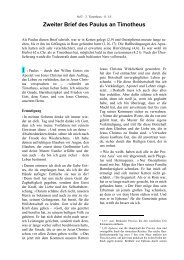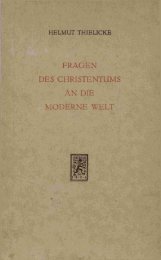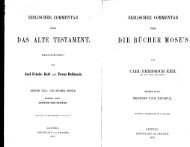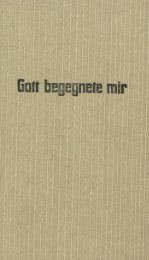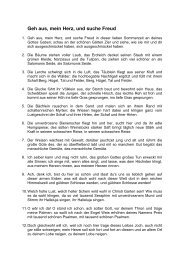Create successful ePaper yourself
Turn your PDF publications into a flip-book with our unique Google optimized e-Paper software.
Loudness, duration, and frequency are the properties<br />
of a sound which inform us of its character<br />
and its origin. But the direction of the sound<br />
is also important. The problem of direction finding<br />
was solved by the Creator when He endowed<br />
us with two ears. To locate the position of a<br />
sound source, two factors are involved: the difference<br />
in intensity, and the time lag. The ear<br />
turned away from a sound source receives the<br />
signal a little softer and somewhat later than the<br />
other one. The brain can also measure the difference<br />
in relative loudness between both ears, and<br />
thus estimate the distance of the sound source.<br />
Although very small, these time and volume differences<br />
are evaluated by the brain in such a way<br />
that the direction can be ascertained with some<br />
precision. This measuring process is so accurate<br />
that a time lag of 0.00003 seconds between the<br />
two ears can be detected clearly. In accoustic orientation<br />
terms this means that a sound source<br />
located only about 3° from the centre line of the<br />
head is recognised as being off-centre.<br />
Measured sound levels: The dB values of various<br />
sounds are given in the table below. Sounds<br />
louder than 90 dB can cause hearing damage,<br />
while a continuous sound of 155 dB can burn the<br />
skin. Some sound sources and their dB levels are:<br />
Source<br />
dB<br />
Limit of audibility 15<br />
Rustling of leaves 18<br />
c) d)<br />
Calculated height<br />
difference for the first<br />
and second sound routes<br />
Lengthened route<br />
Sound coming from below<br />
at an angle of <strong>45</strong>°<br />
6 different possibilities for computational<br />
comparison between the four ”entry<br />
points” for sound (two for each ear)<br />
Left<br />
Upper<br />
Lower<br />
Upper sound<br />
reception area<br />
Right<br />
Lower sound<br />
reception area<br />
The interior of Darwin's<br />
tubercle covers the<br />
portal of the helical<br />
flume<br />
The perpendicular distance<br />
between the sound<br />
reception apertures, calculated<br />
from the difference<br />
in height<br />
Rim of the antihelix<br />
also forms a channel for<br />
sound<br />
Lower edge of the antihelix<br />
functions as a sounding board<br />
Flume formed by the rim of the helix<br />
Calculated<br />
height<br />
difference<br />
Different computational comparisons of sounds by the brain.<br />
c) Six different values: As can be seen from the diagram,<br />
the four separate locations result in six different<br />
sound values to be computed and compared.<br />
d) Sound reception areas: The positions of the sound<br />
reception areas can be clarified by means of this diagram.<br />
If a sound source is located in a direction <strong>45</strong>°<br />
below one's head, then the sound waves reach the upper<br />
reception area along a route which is 9.1 mm longer. The<br />
height of the right-angled triangle would then be 13 mm.<br />
The entry to the tunnel-like rim of the helix is located<br />
below Darwin's bulge. The aperture for the shorter route<br />
1 is located where the rim of the antihelix becomes a<br />
flume. The sound waves are also reflected into the helix<br />
rim by the thickened antihelix from whence it follows<br />
the longer route to the ear canal. It could also travel<br />
along the shorter route. The shortest link between the<br />
two apertures makes an angle of <strong>45</strong>°, so that the difference<br />
between the two routes is about 18 mm (based on<br />
J. Maximilian, E. Irrgang, and B. Andresen).<br />
25




